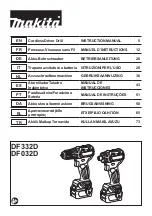
7
Switch action
Fig.3
CAUTION:
•
Before inserting the battery cartridge into the tool,
always check to see that the switch trigger actuates
properly and returns to the "OFF" position when
released.
To start the tool, simply pull the switch trigger. Tool speed
is increased by increasing pressure on the switch trigger.
Release the switch trigger to stop.
Lighting up the front lamp
Fig.4
CAUTION:
•
Do not look in the light or see the source of light
directly.
Pull the switch trigger to light up the lamp. The lamp keeps
on lighting while the switch trigger is being pulled. The
lamp goes out 10 -15 seconds after releasing the trigger.
NOTE:
•
Use a dry cloth to wipe the dirt off the lens of lamp.
Be careful not to scratch the lens of lamp, or it may
lower the illumination.
Reversing switch action
Fig.5
This tool has a reversing switch to change the direction of
rotation. Depress the reversing switch lever from the A
side for clockwise rotation or from the B side for
counterclockwise rotation.
When the reversing switch lever is in the neutral position,
the switch trigger cannot be pulled.
CAUTION:
•
Always check the direction of rotation before
operation.
•
Use the reversing switch only after the tool comes
to a complete stop. Changing the direction of
rotation before the tool stops may damage the tool.
•
When not operating the tool, always set the
reversing switch lever to the neutral position.
Speed change
Fig.6
To change the speed, first switch off the tool and then
slide the speed change lever to the "2" side for high
speed or, "1" side for low speed. Be sure that the speed
change lever is set to the correct position before
operation. Use the right speed for your job.
CAUTION:
•
Always set the speed change lever fully to the
correct position. If you operate the tool with the
speed change lever positioned halfway between the
"1" side and , "2" side, the tool may be damaged.
•
Do not use the speed change lever while the tool is
running. The tool may be damaged.
Selecting the action mode
Fig.7
This tool employs an action mode changing ring. Select
one of the three modes suitable for your work needs by
using this ring.
For rotation only, turn the ring so that the arrow on the
tool body points toward the
mark on the ring.
For rotation with hammering, turn the ring so that the
arrow points toward the
mark on the ring.
For rotation with clutch, turn the ring so that the arrow
points toward the
mark on the ring.
CAUTION:
•
Always set the ring correctly to your desired mode
mark. If you operate the tool with the ring positioned
halfway between the mode marks, the tool may be
damaged.
Adjusting the fastening torque (screwdriver
mode " ")
Fig.8
The fastening torque can be adjusted in 21 steps by
turning the adjusting ring so that its graduations are
aligned with the pointer on the tool body.
First, slide the action mode change lever to the position
of
symbol.
The fastening torque is minimum when the number 1 is
aligned with the pointer, and maximum when the marking
is aligned with the pointer. The clutch will slip at various
torque levels when set at the number 1 to 21. Before
actual operation, drive a trial screw into your material or a
piece of duplicate material to determine which torque
level is required for a particular application.
NOTE:
•
The adjusting ring does not lock when the pointer is
positioned only halfway between the graduations.








































